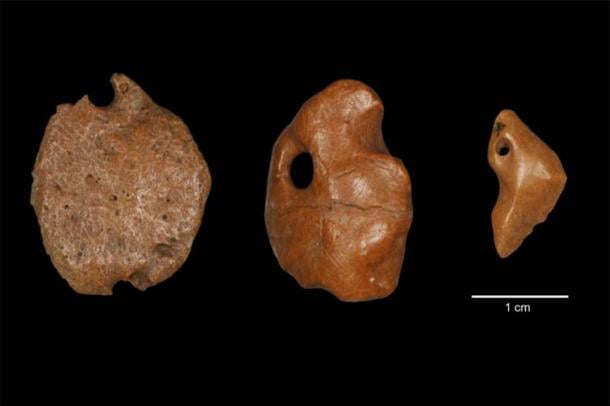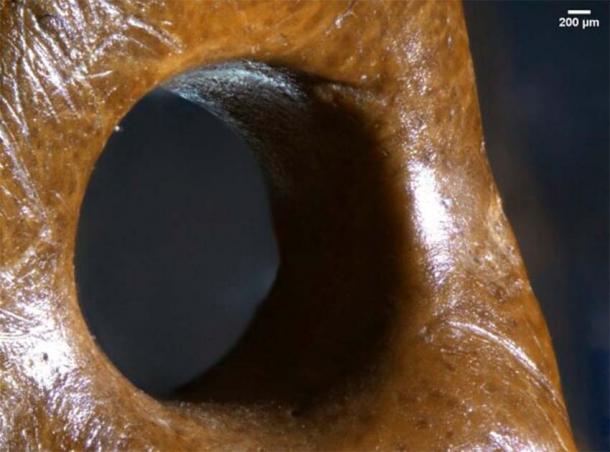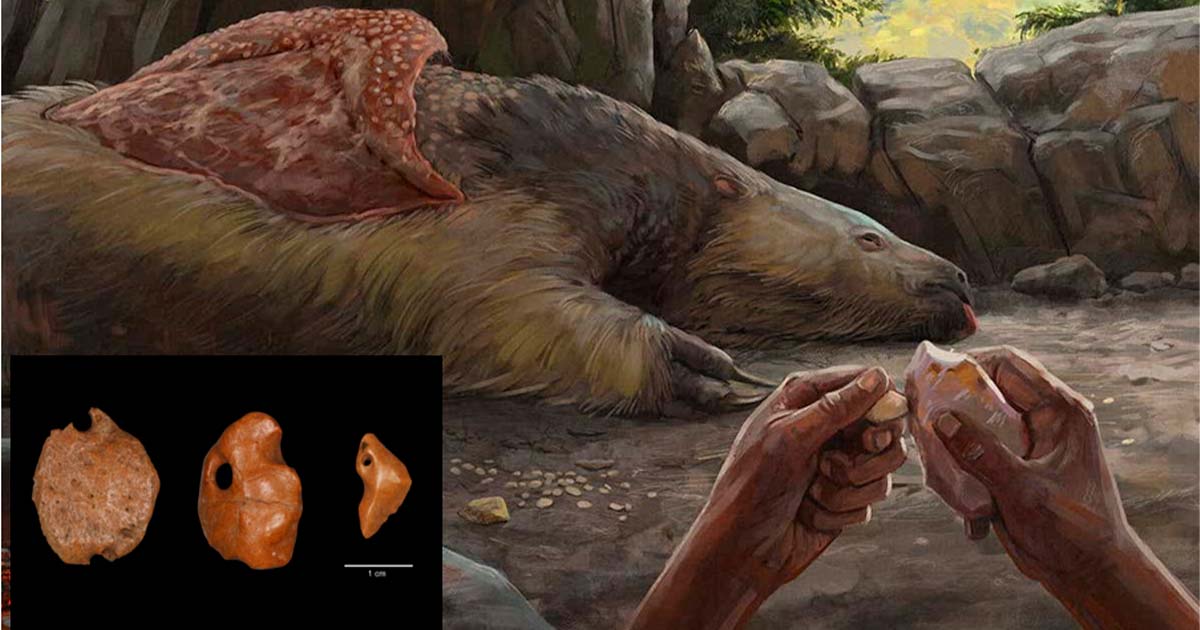Historical Timeline Shook: Human Arrival in South America Pushed Back to 25,000 Years Ago
Human arrival in the Americas has a long-disputed timeline, and new evidence supports pushing back the date for human arrival in South America to at least 25,000 years ago. The evidence? Remains of bones of extinct giant ground sloths, transformed into pendants by ancient inhabitants, found in the Santa Elina rock shelter, situated in central Brazil's Mato Grosso state. Till now, this remains the most compelling evidence for human settlement in the Americas this far back.
Sloth Osteoderms and Human Jewelry Interconnected?
In a fantastic new study published in the Proceedings of the Royal Society B, researchers meticulously examine sloth osteoderms (fossilized bony dermal plates which act as protective armor for animals like armadillos, etc) revealing intricate details that point to human interaction. Three sloth osteoderms in particular were found to bear distinct signs of human working. They were discovered in close proximity to stone tools and displayed minuscule holes that could only have been made by human hands.
"These observations show that these three osteoderms were modified by humans into artifacts, probably personal ornaments," the researchers wrote in their paper.
- 18,000-Year-Old Oregon Rockshelter May Be Oldest North American Site of Human Occupation
- DNA Analysis Reveals Surprising South American Migration Patterns

Sloth bone pendants indicate that humans were in Brazil 25,000 years ago. (Thais Rabito Pansani/The Royal Society Publishing)
Santa Elina Rock Shelter Hiding a Secret for 25,000 Years
Since 1985, The Santa Elina rock shelter has been the subject of archaeological exploration. Prior investigations at the site unveiled numerous stone tool artifacts, extensive rock wall drawings, and thousands of sloth osteoderms. However, the recent study highlights three specific osteoderms with small holes that could only have been made by human hands.
“We now have good evidence — together with other sites from South and North America — that we have to rethink our ideas about the migration of humans to the Americas,” said Mirian Liza Alves Forancelli Pacheco, a study co-author and archaeologist at the Federal University of Sao Carlos in Brazil.
The scientists employed a combination of advanced microscopic and macroscopic visualization technique to analyze the sloth osteoderms. The artifacts exhibit polished surfaces, stone tool incisions, and scraping marks. On top of that, the presence of animal bite marks eliminates the possibility of rodent activity as the cause of these distinctive perforations.
- Evidence Mounts in Favor of Early Inhabitants of the Americas Over 20,000 Years Ago
- Breakthrough in Peopling of the Americas Finds a Female Lineage from China

Researchers in Brazil found three giant ground sloth osteoderms that were polished and had holes in them. (Thaís Pansani/The Royal Society Publishing)
"Electron microscopy and photoluminescence data allowed us to distinguish different types of marks that helped us conclude that the marks attributed to human beings were made on fresh bones or at least before the burial of the carcass," explained Pacheco.
Nonetheless, the shape and abundance of osteoderms lead to speculation that they might have been fashioned into pendants or other specialized items. While the true purpose remains elusive, the discovery highlights the intriguing possibilities surrounding the interaction between ancient humans and their environment.
"Our data are confirmed by the archaeological context as well. Bones and hundreds of osteoderms of the ground sloth are in the same depositional context. "In addition, the skeleton is in an archaeological context with other material elements of the culture, such as stone tools. If the osteoderms were not polished while fresh, they were at least polished as dry remains, which are different from remains that are mineralized by fossilization," Pacheco said.

Close up of the polished pendant. (Thais Rabito Pansani/The Royal Society Publishing)
Human Occupation in South America: An Ever-Expanding Timeline
The unambiguous association between human-modified sloth bones and stone tools, found in geological layers dating back 25,000 to 27,000 years, challenges the existing timeline of human settlement in South America, reports The Associated Press.
This revelation aligns with other controversial evidence suggesting an even earlier human occupation, such as the Toca da Tira Peia rock shelter in eastern Brazil, dating back 22,000 years. These findings open doors to reevaluating our understanding of the migratory patterns and timelines of early human populations in the Americas.
"Our evidence reinforces the interpretation that our colleagues working on Santa Elina have been talking about for 30 years," Thaís Pansani, a paleontologist at the Federal University of São Carlos in Brazil, said in an email to Live Science. This was namely, that "humans were in Central Brazil at least 27,000 years ago."
While the evidence from Santa Elina presents a compelling case for an earlier human presence in South America, it is crucial to recognize that many sites across the continent remain unexplored or inadequately studied.
The ongoing debate surrounding human arrival in the Americas suggests that there is much more to uncover in the rock shelters and caves of Brazil. Lead researcher Pansani anticipates that further evidence awaits discovery. "We believe that there should be more evidence waiting to be found in the rock shelters and caves of Brazil in places little or not explored," Pansani said.
The timing of the ‘peopling’ of the Americas is hotly debated in academia, but the most accepted age for human occupation is around 16,000 years ago, acknowledges Pansani. Recent finds and studies are showing that this timeline is way off, and these researchers hope that this find helps cement that fact.
Top image: Carved giant sloth bones indicate humans in South America. Source: ©Mirian Pacheco/The Royal Society Publishing
By Sahir Pandey
References
Georgiou, K. 2023. Study Says Humans Were in Americas Thousands of Years Earlier Than Thought. Available at: https://www.newsweek.com/new-study-says-humans-americas-thousands-years-earlier-thought-1812323.
Killgrove, K. 2023. Humans were in South America at least 25,000 years ago, giant sloth bone pendants reveal. Available at: https://www.livescience.com/archaeology/humans-were-in-south-america-at-least-25000-years-ago-giant-sloth-bone-pendants-reveal.
Larson, C. 2023. Pendants made from giant sloths suggest earlier arrival of people in the Americas. Available at: https://apnews.com/article/giant-sloths-early-people-americas-4c28e6d96f8bd58ede8ac48e0c39b533.
Pansani, T.R., et al. 2023. Evidence of artefacts made of giant sloth bones in central Brazil around the last glacial maximum. Available at: https://doi.org/10.1098/rspb.2023.0316.
Wetzel, C. 2023. Early humans made jewellery from giant sloth bones. Available at: https://www.newscientist.com/article/2381629-early-humans-made-jewellery-from-giant-sloth-bones/.

















